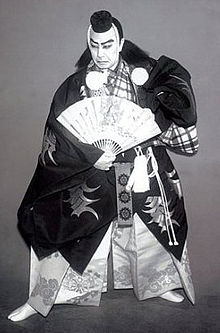- Matsumoto Kōshirō VII
-
Matsumoto Kōshirō VII
七代目松本幸四郎
Kōshirō Matsumoto VII as BenkeiBorn 12 May 1870
Tokyo, JapanDied 27 January 1949 (aged 78) Other names Kōraiya, Ichikawa Komazō VIII, Ichikawa Somegorō IV, Ichikawa Kintarō, Fujima Kan'emon III Matsumoto Kōshirō VII (七代目松本幸四郎)(12 May 1870-27 January 1949) was one of the leading tachiyaku Kabuki actors of Japan's Meiji period (1868–1912) through the late 1940s.
Contents
Names
Like most Kabuki actors, Kōshirō held a number of stage names (gō) over the course of his career. A member of the Kōraiya guild, he would often be called by that name, particularly in the practice of yagō, in which an actor's guild name is shouted out as a cheer or encouragement during a performance. Following in his birth father's footsteps as a master of traditional dance, he bore the stage name Fujima Kan'emon III within that context. In his first appearance on the Kabuki stage, he took the name Ichikawa Kintarō, and would later take the names Ichikawa Somegorō IV and Ichikawa Komazō VIII before coming to be known as the seventh Matsumoto Kōshirō.
Lineage
The son of buyō (traditional dance) master Fujima Kan'emon II, he was adopted into the kabuki theatre by Ichikawa Danjūrō IX, who then became his master. Kōshirō's sons would come to take the stage names Ichikawa Danjūrō XI, Matsumoto Kōshirō VIII, and Onoe Shōroku II; his son-in-law, Nakamura Jakuemon IV, was also an actor, along with many of Kōshirō's grandsons and great-grandsons.
Life and career
Taking the name Ichikawa Kintarō, he made his stage debut in 1881, at the age of eleven. In 1893, by then having become Ichikawa Somegorō IV, he took part in the opening ceremonies of Tokyo's Meiji-za theatre.
He would also take part in the 1911 opening ceremonies of the Imperial Theater, and took the name Matsumoto Kōshirō at a shūmei naming ceremony there only a few months later. Along with the onnagata Onoe Baikō VI and wagotoshi Sawamura Sōjūrō VII, Kōshirō became one of the leading actors of the troupe. Over the following years, he would perform, often alongside these two compatriots, in a number of productions in Tokyo, Kyoto and Osaka, a rare feat for a Kabuki actor. This was in large part due to the differences between the Tokyo (Edo) and Kyoto-Osaka (Kamigata) styles of acting; few actors were particularly successful at performing in both regions. Two of his more common roles in this period, which he played in multiple cities, were those of Nikko Danjō in Meiboku Sendai Hagi and the warrior-monk Benkei in Kanjinchō. Though a specialist in male roles, and in particular the aragoto warrior roles like Benkei, Kōshirō did on occasion also play women, such as Lady Yoshio in Meiboku Sendai Hagi.
Continuing the trade of his birth father, Kōshirō became the head of the Fujima dance school in 1917, and took his father's name, becoming Fujima Kan'emon III; he would use this name when performing buyō traditional dance, but continued to be known as Kōshirō in the theatre world.
Kōshirō continued to perform in all three major cities through World War II, and made his last stage appearance in December 1948, at the Shinbashi Enbujō in Tokyo.
References
See also
- Matsumoto Kōshirō - line of kabuki actors
Categories:- Kabuki actors
- 1870 births
- 1949 deaths
Wikimedia Foundation. 2010.
